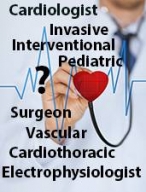So Many Cardiac Specialties –
Unraveling the Heart Physicians
Medically Reviewed by Alan M. Blaker, MD
“The heart and blood vessels comprise an extraordinarily complex system,” says McLeod Cardiologist Alan Blaker, MD. “As a result, a large team of very focused specialists stands ready to diagnosis and treat cardiovascular issues. There are so many specialties, a patient can be confused.” Here’s a quick overview of some of the specialists you may see and a description of their role:
Cardiologist. In general, cardiologists will diagnose, treat and manage patients for their heart and cardiovascular problems. They often work together with a person’s primary physician.
To help diagnose a patient’s problem, the cardiologist might use a stress test with leads attached to an EKG heart monitor during exercise or with medication to check the heart for blood supply problems. Frequently the stress test is done also using a nuclear medicine injection to take pictures of the heart and improve the ability of the stress test to detect problems. Also an echocardiogram may be done using ultrasound to evaluate the heart function and detect any valve problems. If heart problems are suspected after these tests, the cardiologist may perform a cardiac catheterization, inserting dye into the heart arteries and taking x-ray pictures of the heart for a direct look.
Problems a cardiologist might identify include coronary artery disease, congestive heart disease and malfunctioning heart valves, problems with heart rhythms or general chest pain.
Interventional Cardiologist. This sub-specialty is trained to “intervene” with additional minimally invasive procedures to help treat the problem. If one of the main heart blood vessels is blocked, an “angioplasty” is performed, inserting a balloon in the partially blocked artery. The balloon is expanded, opening the artery. A stent (a small metal mesh tube) is then frequently placed after the initial balloon procedure to maintain the blocked artery in an open position. Other procedures done in the artery include: Rotablator, which uses a tiny football shaped diamond tipped burr to spin at high speeds and “drill a space” through a calcified blockage, intravascular ultrasound (IVUS) to look inside the artery using ultrasound, or fractional flow reserve (FFR) to measure pressures across a blocked artery and determine the need for fixing a blockage.
Invasive Cardiologist. Performs all the functions of a cardiologist and also performs cardiac catheterizations to evaluate for blocked arteries and faulty heart valves. The patient can be referred to an interventional cardiologist or cardiac surgeon if balloon angioplasty, stent or surgery is indicated.
Noninvasive Cardiologist. This specialist helps diagnose and treat heart and vascular problems by performing tests such as stress tests and echocardiograms. Blockages and other problems can be pinpointed and the patient can be referred to an invasive or interventional cardiologist for a heart catheterization procedure if needed.
Pediatric Cardiologist. As the name suggests, this sub-specialist is trained in diagnosing and treating heart problems in everything from a fetus or infant to a young adult. The problems can be either hereditary or acquired.
Cardiac Electrophysiologist. Primarily concerned with electrical activities in the heart, an electrophysiologist diagnoses and treats abnormal heart rhythms (too slow, too fast, inconsistent), palpitations, fibrillation (heart valve flutters). In addition to other diagnostic tests, this sub-specialist will run tests by inserting electrical leads in the heart. When medicines are not effective in treating irregular heart patterns, the electrophysiologist might use radio waves (similar to microwave heat) to restore a normal heartbeat.
Some problems in the heart or blood vessels require surgical repair.
Cardiothoracic Surgeon. These specialists are trained to operate on the heart, lungs and thorax (essentially the part of the body between the neck and abdomen). Coronary Artery Bypass procedures, to bypass blockages when blockages are not felt by the treating physicians to be suitable for balloon or stent procedures. Fixing or replacing faulty heart valves and fixing aneurysms in the chest (weak points in arteries) are a regular part of their work.
Thoracic Surgeon will specialize in operations, such as cancer of the lung or esophagus.
Vascular Surgeon. Arteries, veins and the lymphatic systems (which rid the body of toxins) of the heart and brain are the focus of a vascular surgeon. Peripheral Arterial Disease (PAD) is one of the health issues handled by a vascular surgeon. Others include opening arteries to prevent strokes or installing stents in abdominal aortic aneurysms and other clogged blood vessels.
To find a cardiologist or other physician, click here.
Sources include: McLeod Health, National Institutes of Health, Journal of the American College of Cardiology, Society of Thoracic Surgeons, American College of Surgeons
-
McLEOD REGIONAL MEDICAL CENTER FLORENCE
843-777-2000 -
McLEOD DARLINGTON
843-777-1100 -
McLEOD DILLON
843-774-4111 -
McLEOD LORIS
843-716-7000 -
McLEOD SEACOAST
843-390-8100 -
McLEOD CHERAW
843-537-7881 -
McLEOD CLARENDON
803-433-3000



-
McLEOD REGIONAL MEDICAL CENTER FLORENCE
843-777-2000 -
McLEOD DARLINGTON
843-777-1100 -
McLEOD DILLON
843-774-4111 -
McLEOD LORIS
843-716-7000 -
McLEOD SEACOAST
843-390-8100 -
McLEOD CHERAW
843-537-7881 -
McLEOD CLARENDON
803-433-3000
 Find a Doctor
Find a Doctor  Locations
Locations  Services
Services 